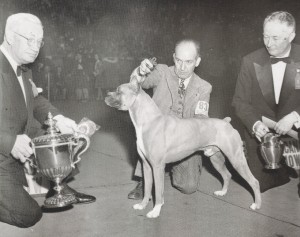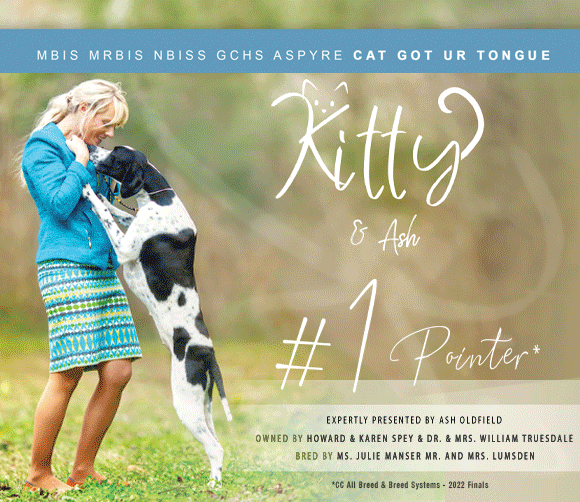Edwin Freund – A Boxer Pioneer
By Amy Fernandez
 It’s fascinating to observe the trajectory of breeds that come out of nowhere and take over the entire game. Partly, that’s because numbers tell only a small part of the story. In fact, breeds don’t suddenly bloom like a big old rosebush. Those winning streaks are built on decades of cooperative effort and hard work.
It’s fascinating to observe the trajectory of breeds that come out of nowhere and take over the entire game. Partly, that’s because numbers tell only a small part of the story. In fact, breeds don’t suddenly bloom like a big old rosebush. Those winning streaks are built on decades of cooperative effort and hard work.
For instance, after WWII Boxers truly dominated the show ring. The breed had been in AKC since 1904. It was a non-starter until a handful of crucial breeders jumped in. From there, it took about a minute before Boxers were winning everything. A couple of names stand out in that context. John Wagner’s Mazelaine dogs of course, and Edwin Freund, who unfortunately didn’t live long enough to see his breed win the jackpot.
Freund died November 12, 1947. An obit in the March 1948 Gazette called him a Boxer pioneer, acknowledging his great contribution to the breed’s success in America. Freund wasn’t in Boxers that long. However, he had two things going for him. He knew what he liked, and he had the money to make it happen. During his tenure in the breed, he imported nine dogs from Germany that earned AKC championships, and he bred another ten champions. By any standard, that’s not a lot.
Look at it this way, Freund might have been a novice in Boxers, but he was no amateur in this sport. He had a lifetime of experience in Bulldogs and a ton of success in that cutthroat competition. In his spare time, he’d also built a fortune in banking, real estate, railroads and everything else that grew up around Chicago money.
Freund had a knack for spotting good prospects, which is how he came to Boxers. Mentored by the legendary James Mortimer, he could read his Non-Sporting competition like a roadmap. And, unlike most Bulldog fanciers, he saw something in the Boxer.
He wasn’t the first. Boxers arrived in America before WWI and had attracted more than a few wealthy backers including N.Y. Governor Herbert Lehman. There was some history, but it hasd one common denominator, Von Dom Kennel, founded on celebrated WWI military dog, Rolf von Vogelsberg, the acknowledged prototype of modern Boxers. Von Dom was the last word in Boxers and John Wagner, in nearby Milwaukee, had already based his Mazelaine kennel on their stock. Wagner had broken new ground with the breed, and he was an obvious source for foundation stock. Since he was also based in the Midwest, he was also Freund’s primary competitor, which upped the ante considerably.
In 1937 Freund purchased 200 acres of property outside of Chicago. He built a home befitting his financial status, but his main objective was Tugley Wood Kennels. He hired the noted Boxer expert Bob Rogers to run the operation. And from there all bets were off.
No one knew it at the time, but geopolitical forces were also on his side. For a few years, Freund could easily do business and import dogs from Germany. Of course, that window was rapidly closing as war overtook Europe. Because of that encroaching horror, typically inaccessible stock was suddenly on offer.
In 1936 Freund’s mentor and rival, John Wagner, had imported Dorian von Dom after intense negotiations. Once he got here, he tore through American competition. As a show dog and a sire, Dorian redefined Boxer competition. And everyone knew about the equally famous Lustig von Dom. Six months younger than Dorian, Lustig had taken the 1935 Sieger title in fawns the same year that Dorian took it in brindles. Lustig was as beautiful as his pedigree promised. A double Sigurd grandson sired by Zorn, his pedigree boasted four crosses back to Rolf v Vogelsberg. He was also the dog that–war or no war–he was a keeper.
No breeder can be faulted for that decision. However, as everything in Germany deteriorated the Stockmanns also knew what was best for the breed. They sold Lustig to Tugley Wood in 1937 for an earth-shattering price of $7000. Add a few zeros to calculate the impact in current monetary terms. Who knows what would have happened to him in Germany. In the U.S., Bob Rogers finished him in a week. Shown just 13 times, he retired undefeated with 10 groups and two BIS. He had bigger stuff to do. He would sire 41 AKC champions and his influence would shape the breed for generations. Like the Stockmanns, Freund shared the wealth with other breeders–and also jumped into the newly minted arena of AKC obedience. Ch. Yaboo of Tugley Woods competed all the way to a U.D. title.
Freund stopped actively showing in 1942. And he only lived long enough to catch a glimpse of what was in store for his breed. At the 1941 ABC specialty, 16 entries were sired by Lustig and 11 by Dorian who unfortunately died suddenly that year. By then, Wagner had imported Ch. Utz von Dom of Mazelaine, a repeat breeding of Lustig. He would win the Westminster group in 1940 and sire 35 champions including Ch. Warlord of Mazelaine.
Freund stopped showing in 1942 but he knew he was on the right track. The year he died, Ch. Warlord of Mazelaine, handled by Nate Levine, became the first Boxer to take Westminster. Levine had shown this dog at Westminster twice before, picking up 11 BIS in between. In 1944, at just 14 months old, Warlord went Best Am-bred In Show and in 1946 he won the group. (In 1936 AKC finally moved Boxers from Non-Sporting to Working). A few years later in 1951, Levine would handle an even more famous descendant to that sweet spot at the Garden.
In coming years, names like Sirrah Crest and Salgray would literally own the sport. To outsiders, it truly seemed like Boxers were conjured up like magic. And I’m inclined to think there was a bit of that going on. But most of it came down to the same boring recipe of big vision and lots of work.
Short URL: http://caninechronicle.com/?p=255174
Comments are closed












